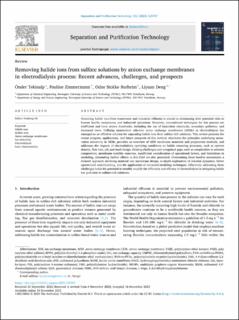| dc.description.abstract | Removing halide ions from wastewater and industrial effluents is crucial to eliminating their potential risks to human health, ecosystems, and industrial operations. However, conventional techniques for this process are inefficient and have severe drawbacks, including the use of hazardous chemicals, secondary pollution, and increased costs. Utilizing monovalent selective anion exchange membranes (AEMs) in electrodialysis has emerged as an effective solution for separating halide ions from sulfate-rich solutions. This review presents the recent progress, applications, and future prospects of this method, elucidates the principles underlying monovalent selectivity in AEMs, provides an overview of AEM membrane materials and preparation methods, and addresses the impacts of electrodialysis operating conditions on halide removing processes, such as current density, flow rate, pH, and stack design. Existing challenges and recognized gaps, such as complexities in solution composition, membrane stability concerns, insufficient consideration of operational factors, and limitations in modeling, demanding further efforts in this field are also presented. Overcoming these hurdles necessitates a focused approach involving material and membrane design, in-depth exploration of solution dynamics, better operational understanding, and the application of advanced modeling techniques. Effectively addressing these challenges holds the potential to notably amplify the efficiency and efficacy of electrodialysis in mitigating halide ion pollution in sulfate-rich solutions. | en_US |

